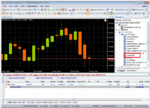Vlado - VertexFX Server Side EA
Vlado is a server side VTL expert adviser. The EA runs on the server auto trading even if the client terminal is closed. This is a unique feature available in VertexFX. Vlado EA is based on Williams percent R indicator. Williams %R is an oscillator, showing overbought oversold market conditions. It oscillates between 0 and -100. %R readings above -50 indicates uptrend and reading below -50 indicates down trend.
A long term Williams %R is used in the Vlado EA. The system open Buy trade when %R is cross above -50 levels and open sell position when %R goes below -50 level. Thus the EA trades long term trend reversal using Williams %R indicator. Position sizing is based on a percentage of account capital risked on each trade.
The EA is customized through the parameters. To change parameters, open the VTL script in VTL editor. Parameters are located at the top of the script. Each parameter is documented in the script for ease of use. The Williams %R period is defined by the parameter “WPR Len”. The %R level for buy and sell is defined by the parameter “WPR Level”. Parameter “Maximum Risk” determines the percentage of capital to risk on each trade. Its default value is 10%.
To run the EA on the server, open the EA in VTL editor and click the Run button. This will save the EA to the server and start it on the server.

Vlado is a server side VTL expert adviser. The EA runs on the server auto trading even if the client terminal is closed. This is a unique feature available in VertexFX. Vlado EA is based on Williams percent R indicator. Williams %R is an oscillator, showing overbought oversold market conditions. It oscillates between 0 and -100. %R readings above -50 indicates uptrend and reading below -50 indicates down trend.
A long term Williams %R is used in the Vlado EA. The system open Buy trade when %R is cross above -50 levels and open sell position when %R goes below -50 level. Thus the EA trades long term trend reversal using Williams %R indicator. Position sizing is based on a percentage of account capital risked on each trade.
The EA is customized through the parameters. To change parameters, open the VTL script in VTL editor. Parameters are located at the top of the script. Each parameter is documented in the script for ease of use. The Williams %R period is defined by the parameter “WPR Len”. The %R level for buy and sell is defined by the parameter “WPR Level”. Parameter “Maximum Risk” determines the percentage of capital to risk on each trade. Its default value is 10%.
To run the EA on the server, open the EA in VTL editor and click the Run button. This will save the EA to the server and start it on the server.



















